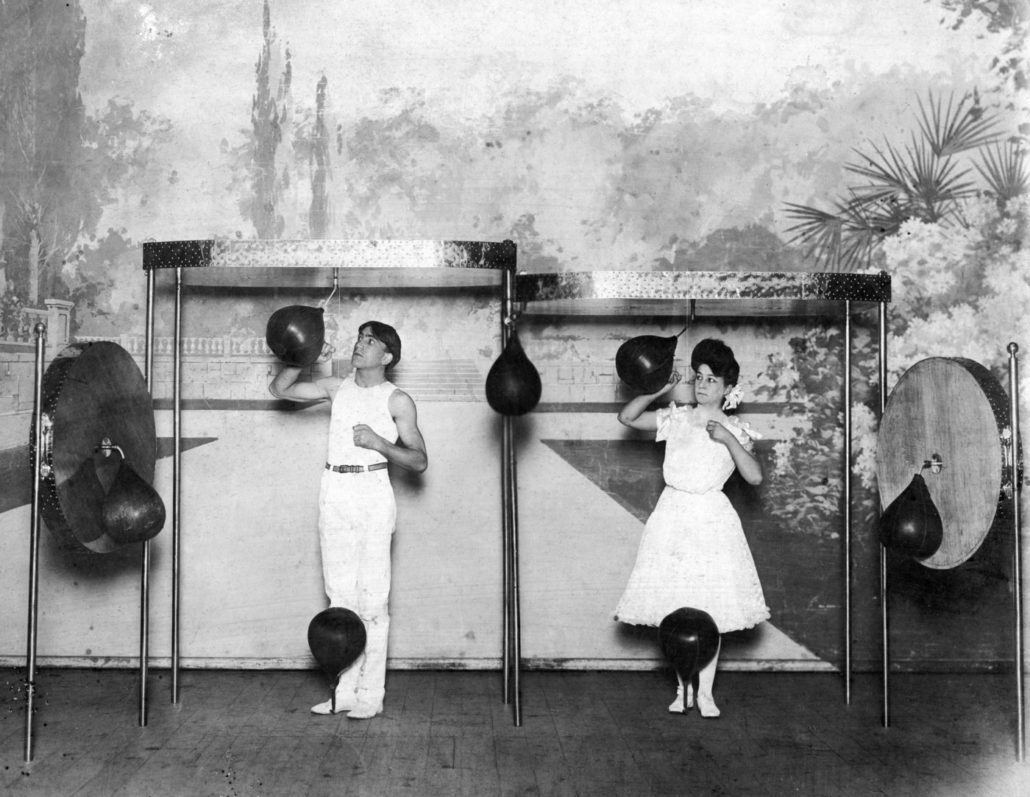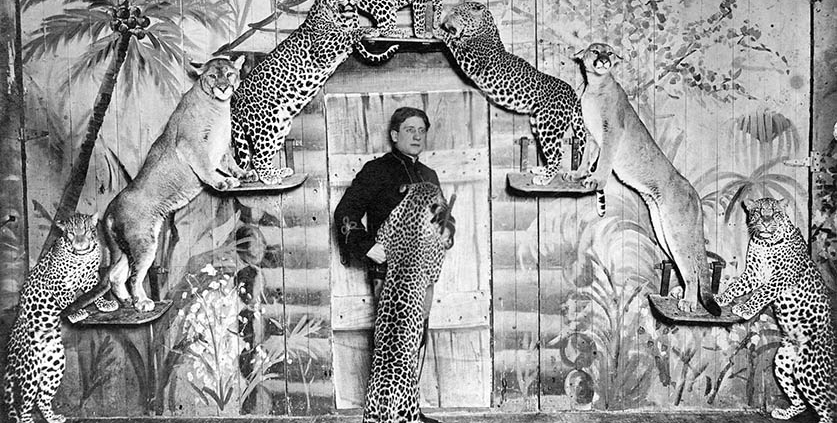Vintage Vaudevillians
/in Past Exhibitions /by Christina ClaassenSeptember 19, 2020 - May 16, 2021
Old City Hall
Curated by Jeff Jewell, Historian and Archivist
Vintage Vaudevillians is a photographic exhibition that highlights a dozen vaudeville acts that performed in Bellingham in the early 20th century. Originally used to promote the acts, these publicity photos were saved by James Warwick, stage manager at downtown theaters during vaudeville’s heyday.
James “Jim” Warwick had a 54-year career in Bellingham theaters, starting as a stagehand at the Lighthouse Theatre in 1897. He was stage manager at both Beck’s Opera House and The Grand during the heyday of vaudeville in the early 20th century when Bellingham was on the competing Pantages and Sullivan-Considine circuits. Warwick worked directly with performers, catering to their needs and whims, and had a longstanding reputation as a dependable, gracious host.
Vaudevillians, once scheduled by a venue, commonly forwarded photographs of themselves to the theater for use in advance publicity. After their week-long gig, the promotional portraits were returned to the act or, more typically, thrown away. But Warwick kept them as souvenirs of the personalities and performances he witnessed on the Bellingham stage.
With the rise of motion pictures and subsequent disappearance of vaudeville, Warwick worked as a film projectionist for more than 30 years at the American Theater on Cornwall Avenue. After his death in 1967, his daughter Mary donated his collection — more than 750 photographs from the vaudeville era — to the Whatcom Museum.
The Whatcom Museum acknowledges that we gather on the traditional territory of the Lhaq’temish – Lummi People – and the Nuxwsá7aq – Nooksack People – who have lived in the Coast Salish region from time immemorial. The Museum honors our relationship with all of our Coast Salish neighbors and our shared responsibilities to their homeland where we all reside today.
Arnold’s Big Cat Act, 1910
The leopards and cougars were described as “well-groomed, in splendid condition, their coats look as smooth as velvet and they are not wanting in the delicacies of the table.”
Arnold, their lionized keeper, was “looking quite at home with his pets, which he fondles, pets and commands with equal facility and success.”
Photo by Frank T. Dunlap (New York, NY); James Warwick Collection No. 226
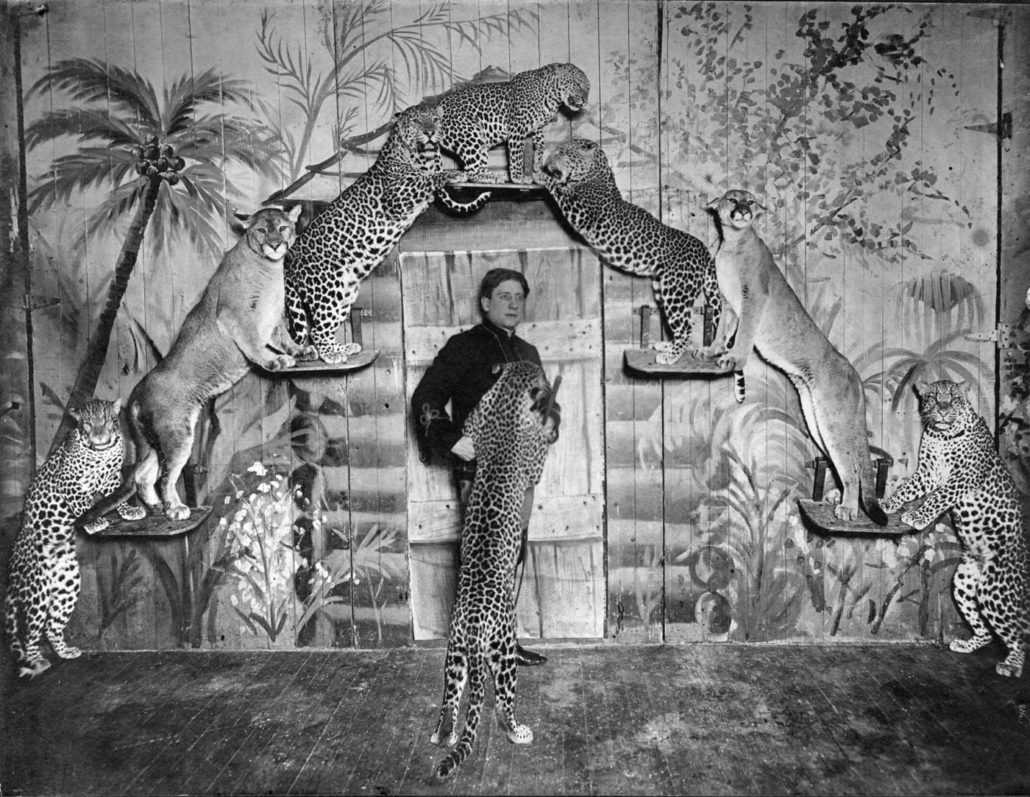
Phroso, The Mysterious Mechanical Doll, 1909
What was he, man or “Automaton?” That was the question posed to audiences by Phroso, who “is marvelously like a man in looks, but in action is stiff and its movements are accompanied by a low buzz as of electrical machinery at work.”
Frederick Trevallion had been inspired to build Phroso after seeing Madame Tussaud’s wax figures in London. Trevallion’s life-like doll, however, could walk and dance. We bet he did an awesome Robot!
Prior to an evening performance, Phroso was often displayed in a downtown shop window where he’d stand for hours with a “peculiar glassy stare.” Dressed like a man-sized toy soldier, he wore “a beautiful sword presented to him by King Edward of England.” Phroso was last seen in 1932, working as a clothing store mannequin in Ogden, Utah.
Photo by Frank Heinisch (New York, NY); James Warwick Collection No. 74
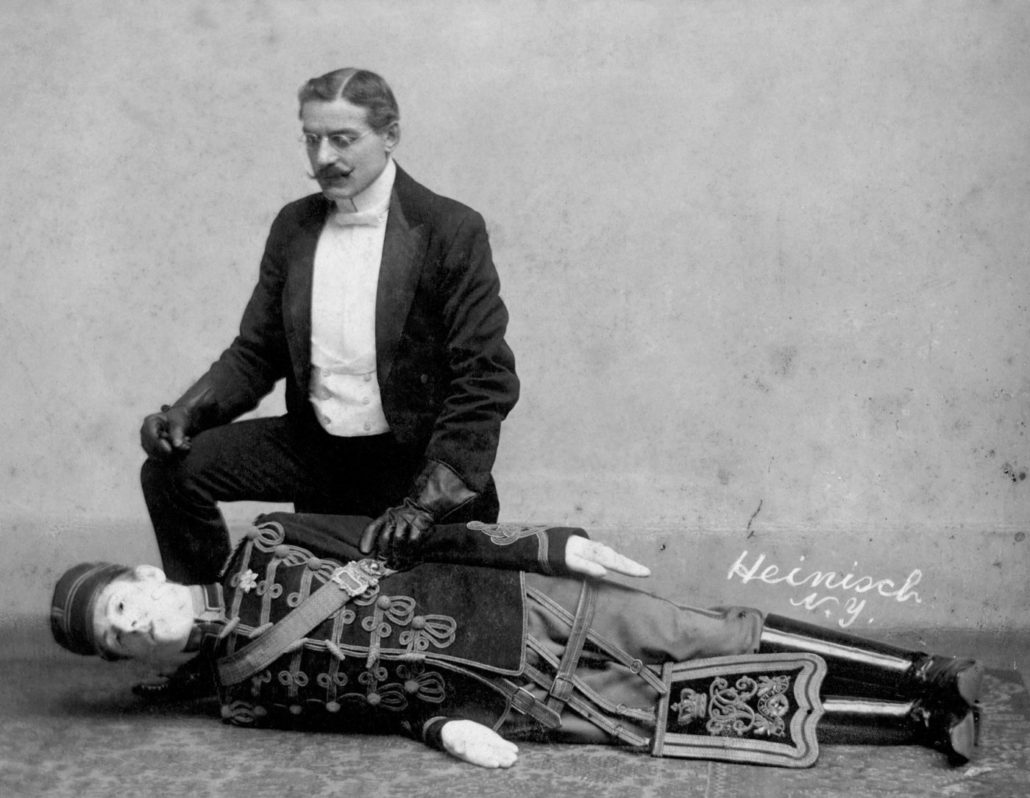
Mantle & Tell, Sure Shots, 1898
All the way from Australia, Lillie Mantle and Rosy Tell were “rifle shot and sword combat artists.” Did they use live rounds inside the auditorium? We don’t know, but how else to exhibit their marksmanship? Signed on April 9, 1898, this photo is the oldest in Warwick’s collection and could well mark where Jim’s collecting began. It dates to when he was a stagehand for both the Lighthouse Theater and Bellingham Opera House in New Whatcom.
The image was meticulously painted by hand to give it color, quite an investment for something relegated to promotional use.
Photo by Talma Studio (Melbourne, Australia); James Warwick Collection No. 127
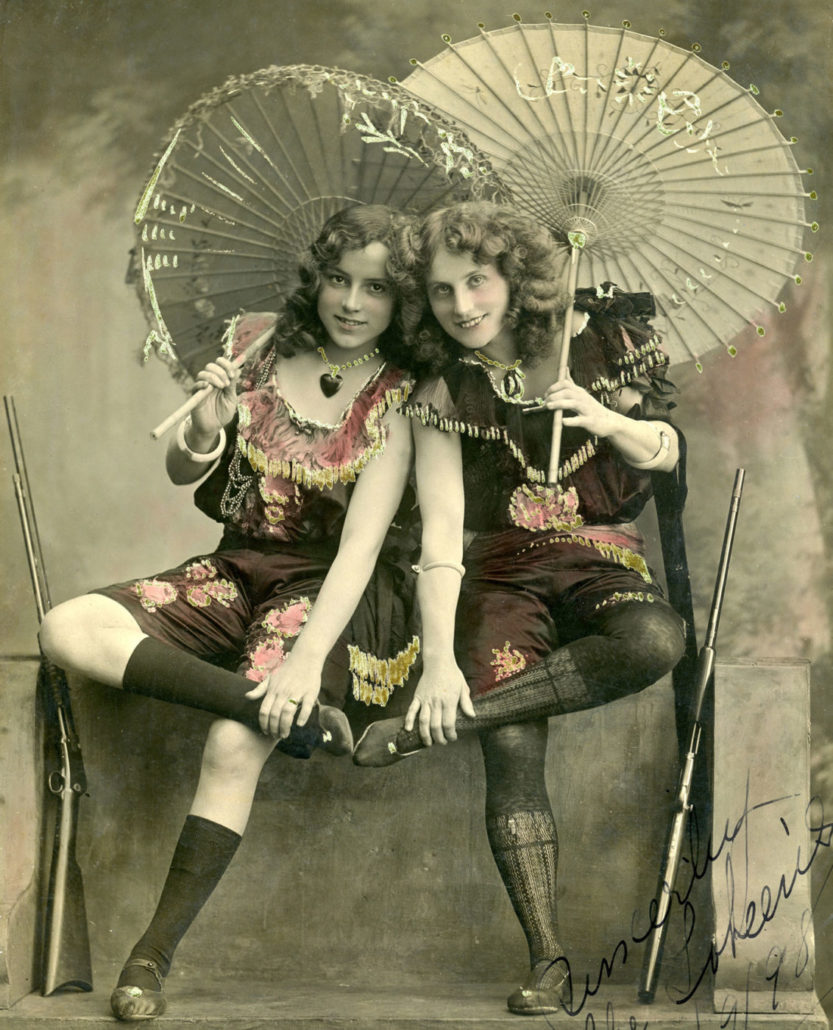
The Carson Brothers, Modern Athletes, 1908
Billed as “Apollos of Vaudeville, Marvels of Grace and Strength,” these “two famous strong men will demonstrate their ability to lift heavy weights and will in other ways display their skill in feats requiring great muscular development.”
At the Grand for Christmas week 1908, “they also do some very artistic posing in which they represent classical figures.”
Photo by Axel Horner (Brooklyn, NY); James Warwick Collection No. 118
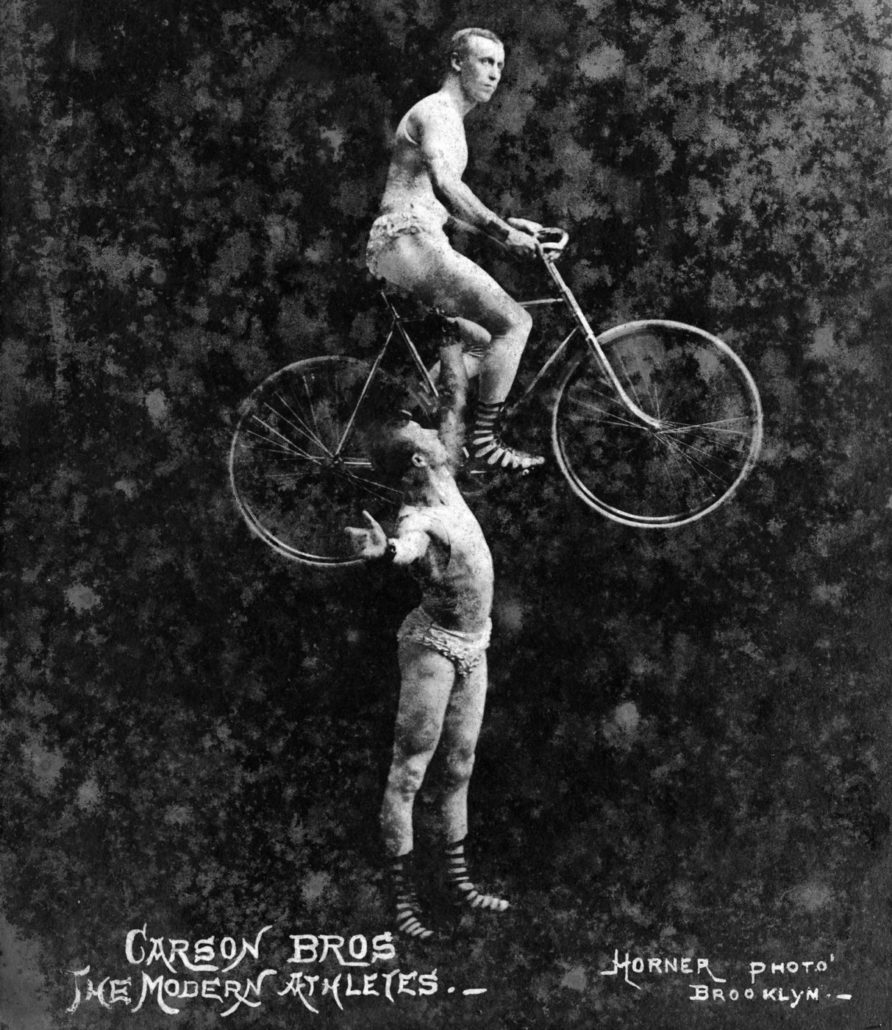
Wilfred & Lottie, Masters of Somersaults, 1908
This “Equilibrist and Acrobatic Dog” duo from Winnipeg, Manitoba, brought their “clever stunts” to Bellingham’s Grand Theater during the final week of April 1908. There was an axiom among vaudeville entertainers that you never wanted to follow “a mutt act.”
Always an audience favorite, stage pooches were mostly energetic comedians, playing tricks on a befuddled trainer with the dog getting the better of their human “master.”
Photo by Gauvin, Gentzel & Co. (Winnipeg); James Warwick Collection No. 138
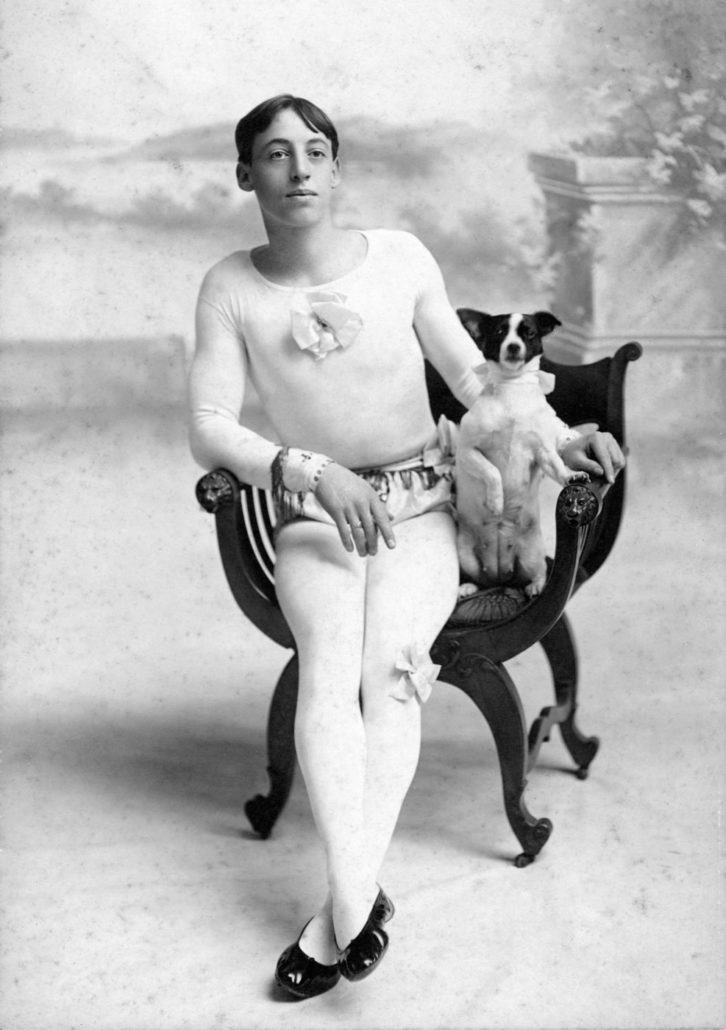
Fern & Harris, No Strings Attached, 1908
Mildly spooky, these “mystifying Parisian illusionists” brought their “delusive” performance to the Grand Theater in February 1908. Enthusiastic reviews upheld the spirit of the act: “By the hypnotic power of Mr. Harris see the lady dance in mid-air!”
While Fern defied gravity, “a wand is pressed all around her so as to convince the audience that there are no wires or ropes which hold her from the floor.” Who would ever suspect such a thing?
Photographer unknown; James Warwick Collection No. 175
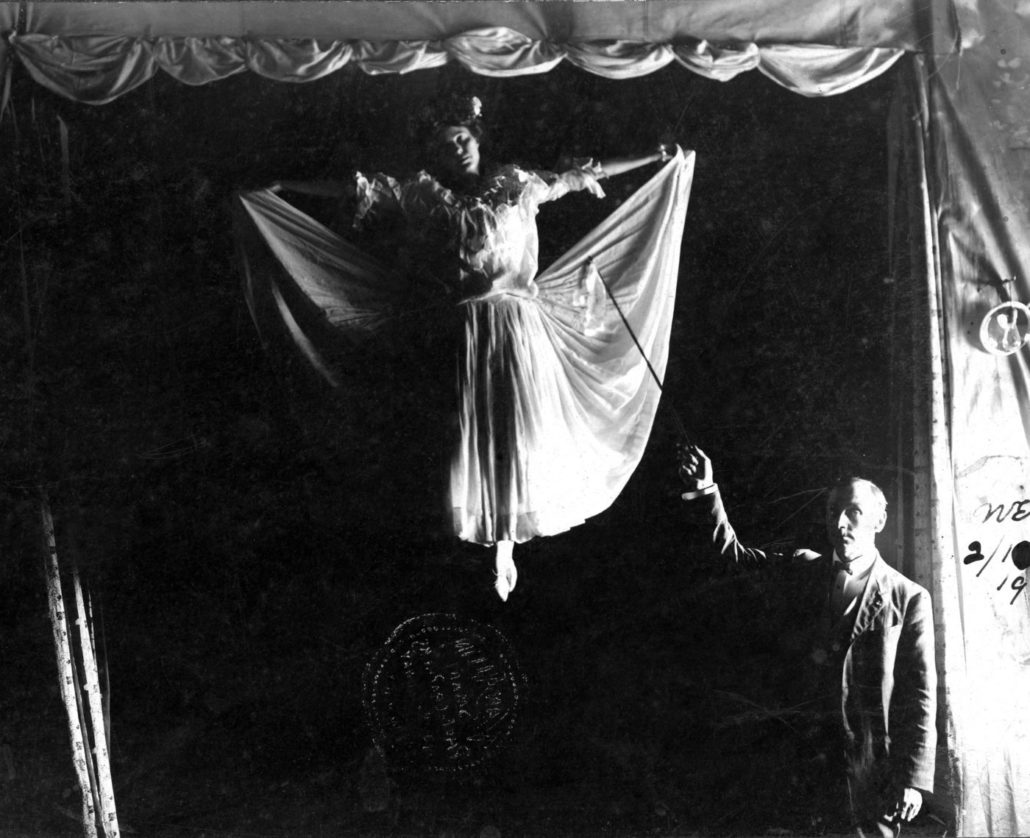
Cora Hummell, Intense Elocutionist, 1908
For a week at the Grand in March 1908, Cora Hummell delivered her dramatic interpretations of well-known soliloquies. Originally from Seattle, she’d moved to New York to become a Broadway actress and found a vaudeville niche as an “impersonator of great actors.”
She married Walter Wellman, wealthy manager of the Block Light Company, who discouraged her artistic inclinations. After their modestly salacious divorce made the back pages of national newspapers in 1913, Hummell resumed her career reciting “scenes from Shakespeare” and the poetry of Ella Wheeler Wilcox. She gained further distinction for cultivating roses and as a motivational speaker.
Photograph by White Studios (New York, NY); James Warwick Collection No. 195
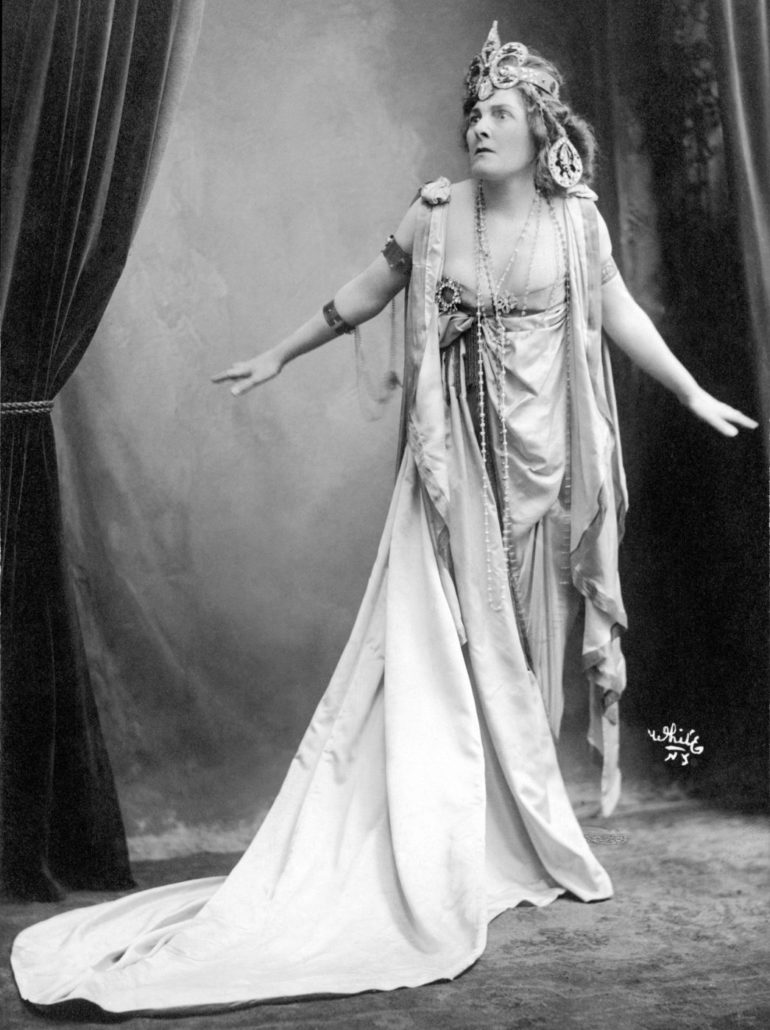
Mary Pickford, Queen of the Silent Screen, 1917
James Warwick’s theater career spanned the rise of movies and subsequent disappearance of vaudeville. Moving pictures were at first only a few minutes in length; the soundless “Edison” scored live by the theater’s piano player.
As the technology developed, Warwick went from being a stage manager to a film projectionist. There are a dozen studio stills from the silent era in Jim’s collection; he was obviously fond of Tom Mix, cinematic cowboy, and actress Mary Pickford, “America’s Sweetheart.”
This promo is from Pickford’s 1917 film The Pride of the Clan in which her character, 18-year-old Marget MacTavish, inherits the keys to her Scottish family’s chiefdom. Mary is the namesake to Bellingham’s Pickford Theater on Bay Street.
Photographer unknown; James Warwick Collection No. 203
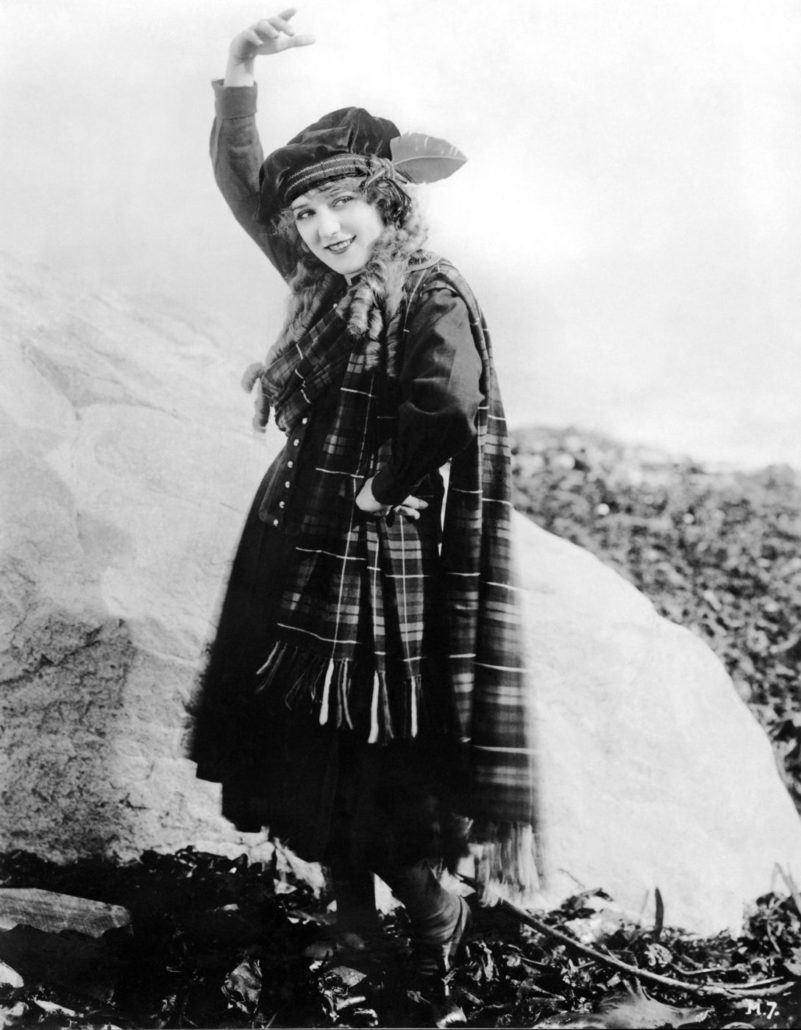
Bartholdi’s Troupe of Cockatoos, 1908
Vaudeville acts were fashioned around talking parrots, spelling pigeons, even “educated roosters,” but the apex of avian acts involved cockatoos. The Bellingham Herald’s reviewer raved about Bartholdi’s brood, concluding “most everyone is thoroughly familiar with these birds, as well as parrots, but it is safe to say no one ever saw a cockatoo perform on wire and bicycle as these do, and the act is just what is claimed for it – par excellence.”
Recognizable among the cast, perched on their apparatus, are Sulphur-crested, Galah, Major Mitchell, and Umbrella cockatoos. There are four Scarlet macaws up on the top tier.
Photographer unknown; James Warwick Collection No. 277
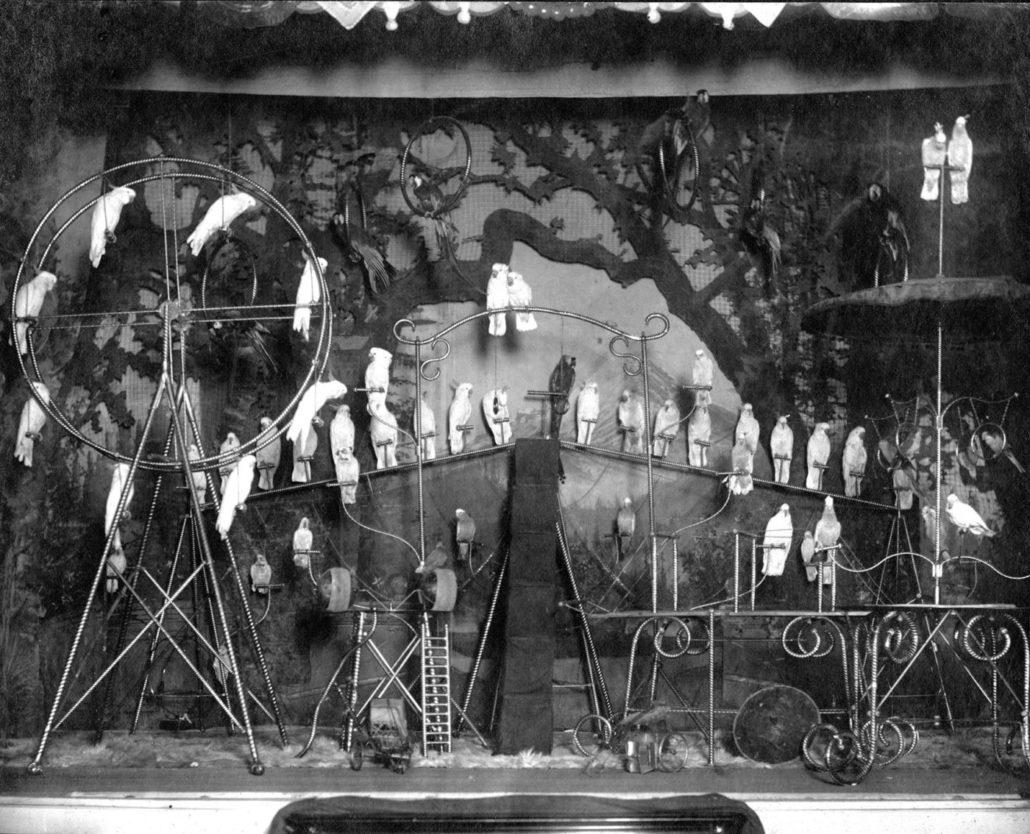
Al Carlisle’s Pony and Dog Circus, 1908
This photo doesn’t capture the slapstick mayhem brought to the stage by three ponies and ten dogs! Where are the pups? Besides the customary choreographed chaos, at various interludes the canines donned adorable costumes and performed skits known as the “Dogville Pantomime.”
The equine contingent pictured here, left to right, are Jerry, Irish, and “Tom, the talking pony.” Appearing at the Grand Theater in March 1908, this mini circus was “especially designed to please the children.”
Photographer unknown; James Warwick Collection No. 285
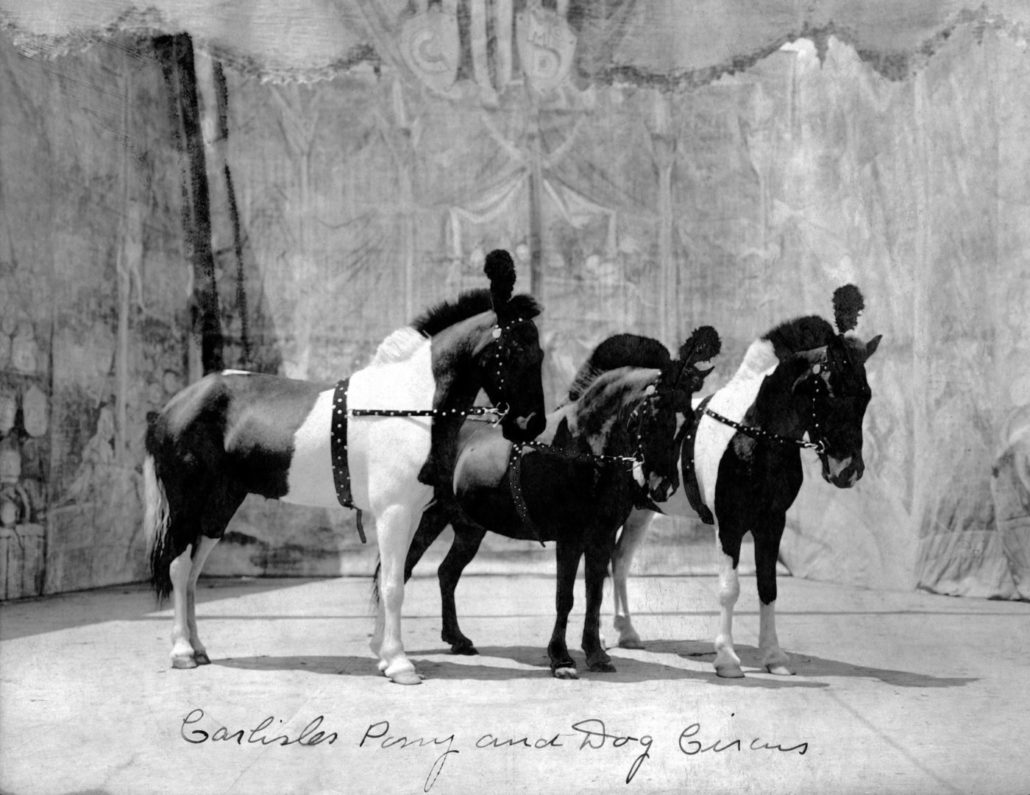
Oregon Ben, Incredibly Inked, c. 1907
Tattooed in “seven colors and 500 beautiful designs,” Oregon Ben wasn’t so much a vaudeville act as a flaunted spectacle. Not a song and dance man, he was available for “Private Exhibitions” and was a type of novelty more likely found in circus sideshows. Tats were that exotic.
Oregon Ben’s torso was a canvas for Hugo Jules Spitzer, a renowned tattoo artist working in Seattle. After “Professor Spitzer” moved to Portland, Oregon, Ben remained a shirtless celebrity around Pioneer Square, for years advertising a First Avenue tattoo parlor and penny arcade.
Photo by Angelus Studio (Seattle, WA); James Warwick Collection No. 293
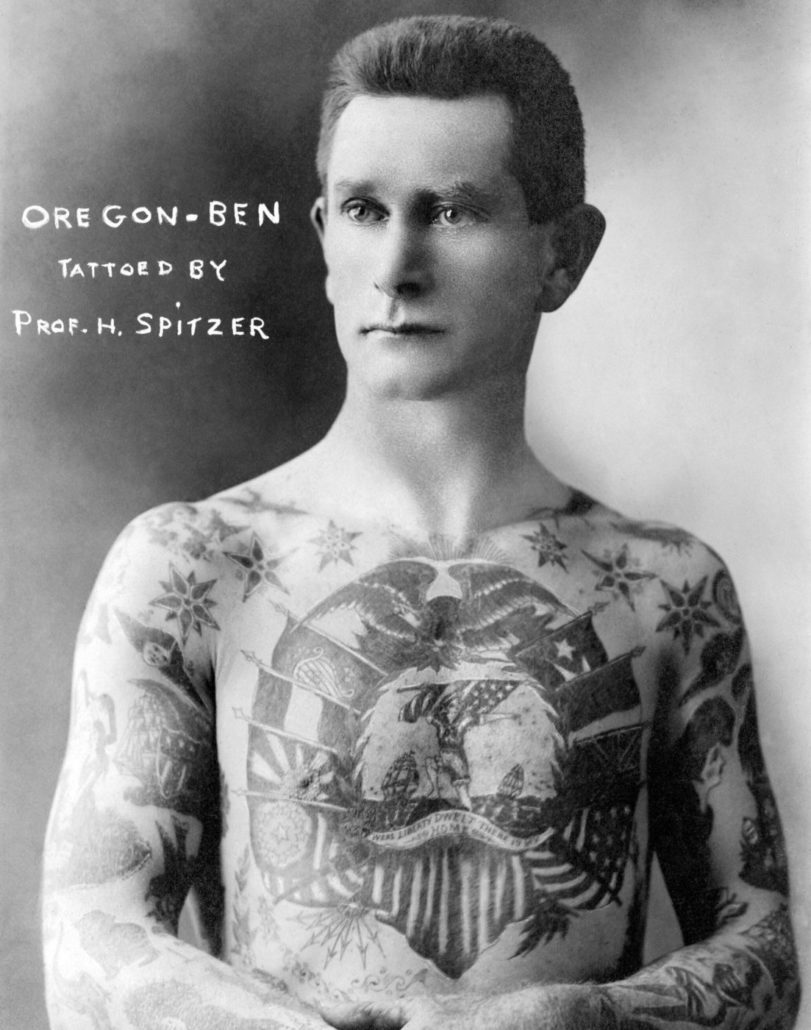
Myrtle Fischer, Electrical Dancer, 1905
Miss Fischer’s dancing wasn’t routine, not with “125 light globes on her costume” outlining her moves on stage in the darkened theater. There’s no record of what musical accompaniment she received, but she could control the various strings to achieve “changing color of illumination.”
Note those are four lightbulbs in her hair! Unique among performers in the Warwick Collection, 17-year-old Myrtle Fischer was a “Bellingham girl.” Before taking to the vaudeville circuit, she attended Fairhaven High School in the original Larrabee School on 19th Street.
Photo by Charles E. Abbott (Bellingham, WA); James Warwick Collection No. 298
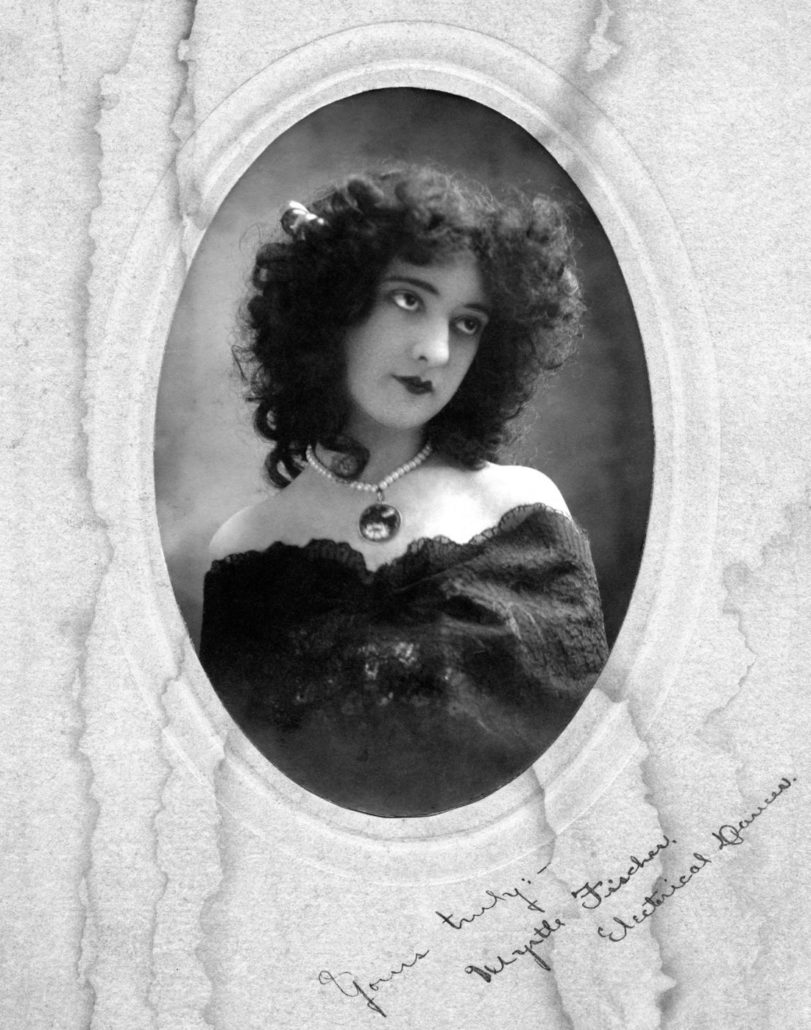
Princess Trixie Finds the Answer, 1904
The vaudevillian horse was typically two guys in an equestrian costume with the one in the rear-half serving as the butt of jokes. Princess Trixie, an “educated horse” from Sioux City, Iowa, was the real deal. In April 1904, she charmed Bellingham audiences at the Grand Theater by solving “mathematical” problems and “standing on her head.” The Bellingham Herald proclaimed there wasn’t “a horse in the country that shows so much intelligence as does Trixie.”
The princess, under the tutelage of showman W. H. Barnes, was a sensation at the Lewis & Clark Centennial Exposition in Portland, Oregon, in 1905; that same year her “autobiography” (as dictated to George Hutchin) was published.
Photo by Waltermire Studio (Sioux City, IA); James Warwick Collection No. 656
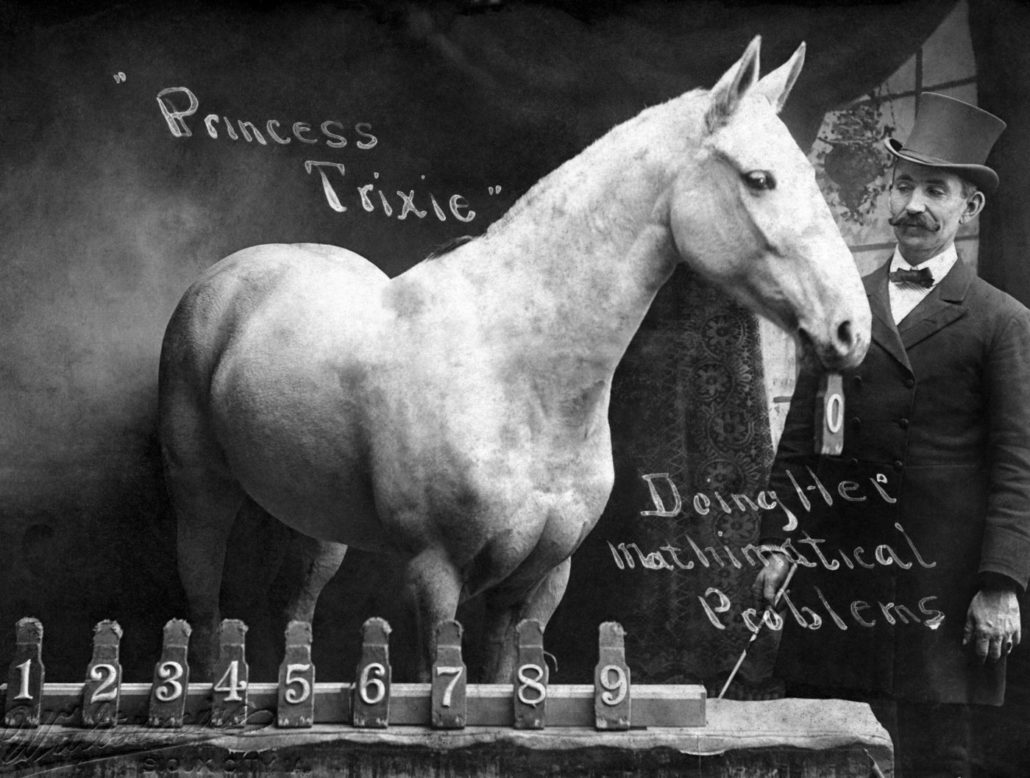
Mr. & Mrs. Milo Vagge’s Exercise Exhibition, 1906
This married couple went through a workout of synchronized “bag punching” and “artistic hoop rolling” during their week at the Grand Theater in September 1906. They appeared fourth on a bill of five acts.
The program concluded with an “illustrated song,” an audience sing-along that had lyrics projected by Magic Lantern and music played by the theater’s own Grand Peerless Orchestra. Matinees were 10 cents; evening shows 20 cents.
Photographer unknown; James Warwick Collection No. 695
